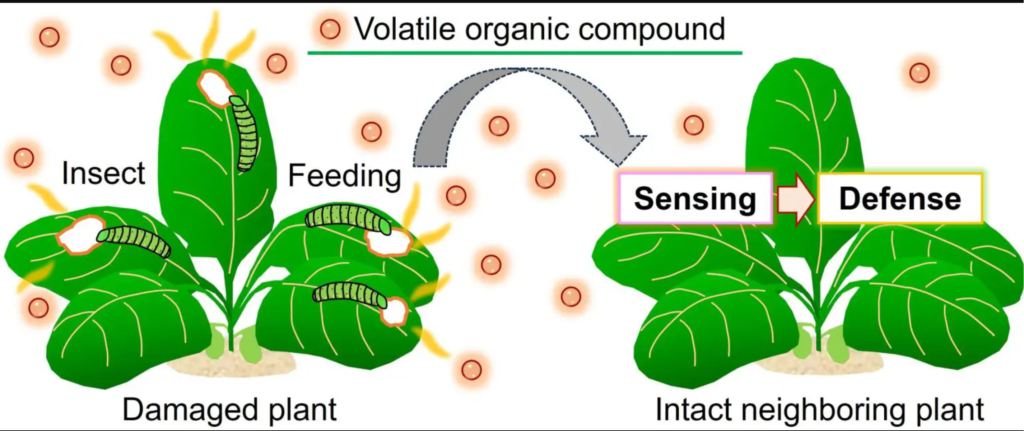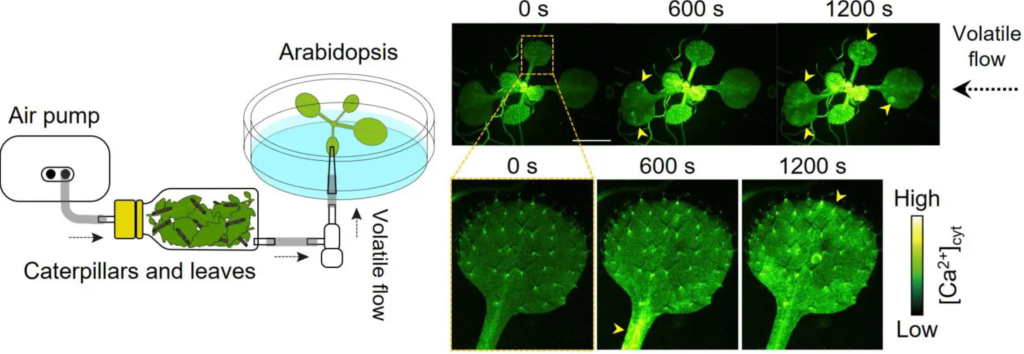Through the use of airborne chemicals VOC, researchers have been able to visualise plant-to-plant communication and have identified the precise signals and physiological reactions that trigger plant defences against dangers.
Airborne Communication Among Plants: Via VOC
When plants are attacked by insects or sustain mechanical injury, they release volatile organic compounds (VOCs) into the environment. The emitted VOCs are perceived by unharmed nearby plants as warning signs to initiate defensive mechanisms against potential dangers (Figure 1). Since its initial documentation in 1983, the phenomena of plants communicating through the air using volatile organic compounds (VOCs) has been seen in over thirty distinct types of plants. It is yet unknown, nevertheless, what chemical pathways underlie VOC perception to defence induction.

Figure 1: Plants release VOCs into the atmosphere when damaged by insects. Intact neighboring plants sense VOCs and activate pre-emptive defense responses against the insects. Credit: Masatsugu Toyota/Saitama University
Groundbreaking Visualization of Plant Conversations
Under the direction of Professor Masatsugu Toyota of Saitama University in Japan, the team demonstrated how VOCs are absorbed by plants and trigger Ca2+-dependent defence mechanisms in reaction to potential threats. They also visualised plant-to-plant communications using VOCs in real-time.
On October 17, 2023, this ground-breaking study will appear in the journal Nature Communications. As Ph.D. candidates and postdoctoral researchers in Toyota’s lab, respectively, Yuri Aratani and Takuya Uemura oversaw the study and worked with Professor Kenji Matsui of Yamaguchi University, Japan.
ALSO READ :Natural Selection Surprises: Evolutionary Insights From Florida’s Wild Lizards
Toyota explains, “We built machinery to pump VOCs released by plants fed by caterpillars onto neighbouring, undamaged plants and combined it with a real-time, wild-field fluorescent imaging system.” This creative arrangement showed how the VOCs released by the insect-damaged plants caused bursts of fluorescence to spread in an Arabidopsis thaliana mustard plant (Figure 2; Video 1). Because plants produce fluorescent protein sensors for intracellular Ca2+, variations in fluorescence can be used to track changes in intracellular Ca2+ concentration.
In addition to insect attacks, VOCs released from manually smashed leaves induced Ca2+ signals in undamaged neighboring plants,” says Toyota (Video 2).

Figure 2: Left panel: Equipment for exposing intact Arabidopsis to VOCs emitted by insect-damaged plants (dashed arrow). Right panel: Ca2+ signals (yellow arrowheads, 600 and 1200 s) were induced by VOCs released from insect-damaged plants (dashed arrow). Credit: Masatsugu Toyota/Saitama University
Identification of Key VOCs and Their Impact
Toyota experts looked at a variety of volatile organic compounds (VOCs) that are known to cause defence responses in plants in order to determine what kind of VOCs caused Ca2+ signals in plants. It was discovered that two volatile organic compounds (VOCs) that are six-carbon aldehydes, (Z)-3-hexenal (Z-3-HAL) and (E)-2-hexenal (E-2-HAL), cause Ca2+ signals in Arabidopsis (Figure 3; Video 3). Green leaf volatiles (GLVs) are grassy-smelling chemicals released into the air by plants that have been injured by herbivores or mechanical means. These compounds include Z-3-HAL and E-2-HAL.
Z-3-HAL and E-2-HAL exposure caused Arabidopsis to upregulate genes linked to defence. They used the Ca2+ chelating agent EGTA and the Ca2+ channel inhibitor LaCl3 to treat Arabidopsis in order to better understand the connection between the Ca2+ signals and the defence responses. These compounds demonstrated that Arabidopsis senses GLVs and initiates defence responses in a Ca2+-dependent way by suppressing both the Ca2+ signals and the activation of defense-related genes.

Figure 3: Airborne Z-3-HAL (orange broken line) induced Ca2+ signals (yellow arrowheads, 120 and 370 s) in Arabidopsis leaves. Credit: Masatsugu Toyota/Saitama University
Guard Cells: Plants’ Gateway to Awareness
By creating transgenic plants that express the fluorescent protein sensors just in guard, mesophyll, or epidermal cells, they were also able to determine which particular cells displayed the Ca2+ signals in response to GLVs. When exposed to Z-3-HAL, guard cells produced Ca2+ signals in about a minute, followed by mesophyll cells; epidermal cells produced Ca2+ signals more slowly (Video 4). On the surface of plants, guard cells take the form of bean-shaped cells called stomata, which are tiny apertures that link the atmosphere and internal tissues.
According to Toyota, “stomata act as a plant gateway mediating rapid GLV entry into interspaces in leaf tissues,” despite the fact that plants do not have a “nose.” Specifically, they discovered that Ca2+ responses in wild-type leaves were decreased by pretreating with abscisic acid (ABA), one of the phytohormones renowned for its capacity to close stomata. Conversely, even in the presence of ABA, mutants with compromised ABA-induced stomatal closures were still able to produce normal Ca2+ signals in their leaves.
“The complex tale of when, where, and how plants react to aerial ‘warning signals’ from their endangered neighbours has finally been revealed,” he claims. He continues, “This ethereal communication network, hidden from our view, plays a pivotal role in promptly protecting neighbouring plants from imminent threats.”
This pioneering research not only deepens our appreciation for the astonishing world of plants but also underscores the remarkable ways in which nature has equipped them to thrive and adapt in the face of adversity. The profound implications of these findings resonate far beyond the boundaries of plant science, offering a glimpse into the intricate tapestry of life on Earth.
Reference: “Green leaf volatile sensory calcium transduction in Arabidopsis” 17 October 2023, Nature Communications.
DOI: 10.1038/s41467-023-41589-9
source: SciTechdaily
ALSO READ :Scientists Create A Bionic Hand That Integrates With The User’s Nervous And Skeletal Systems




































